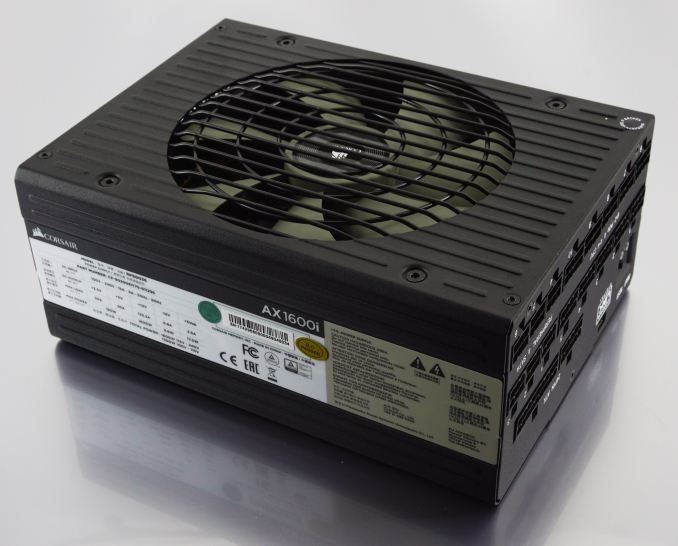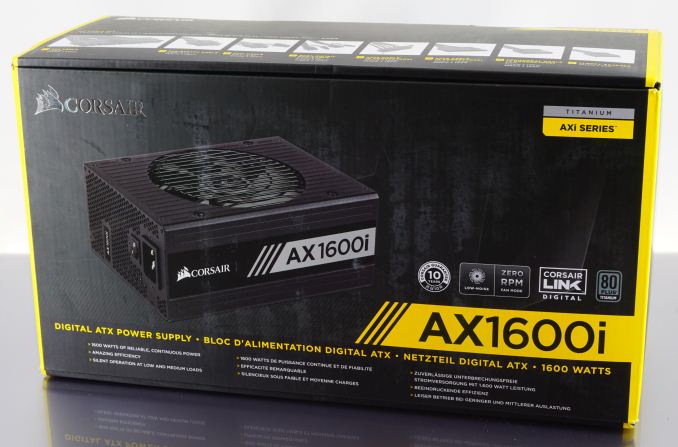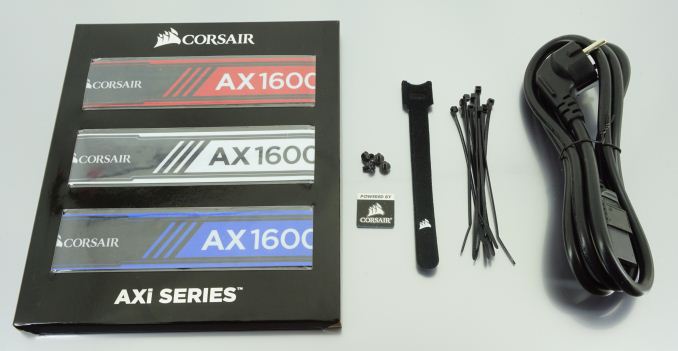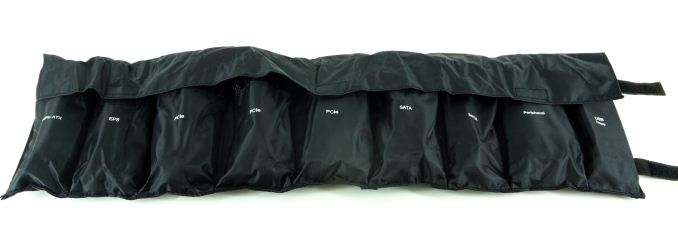The Emperor of Efficiency: Corsair's AX1600i PSU Rules Alone (Review)
by E. Fylladitakis on April 18, 2018 9:30 AM EST
Corsair is a company that needs no introduction. They are one of the oldest names in the PC industry and, although they initially only marketed memory-related products, nowadays the company has diversified into most segments of the PC market, with products ranging from PC hardware components to office/gaming chairs.
The company has been particularly active in the PC power supply (PSU) market. It was one of the first markets the company diversified into, and their first few products that the company released over a decade ago were a huge success. Nowadays Corsair is one of the biggest players in the PC PSU market, with dozens of competitive products covering every want and need.
The company places a lot of weight on their PSU division, which has been one of the innovation leaders during the past decade, always coming up with new features and/or technological upgrades. It is no chance that Corsair's units were always amongst the first to meet the new 80Plus programme certifications when they were being introduced. Corsair has always been trying to be a technological step ahead of their competition, striving to bring the best out in the market first.
It is somewhat of a tradition for Corsair to always have one pinnacle product, a PSU that has no equal in the market, regardless of the cost. For quite some time this PSU was the AX1500i, a behemoth PSU with 80Plus Titanium certification. While the 80Plus Titanium certification is rare and costly even today, Corsair achieved it four years ago. As the electrical performance of the AX1500i already was outworldish and there are no better quality or efficiency certifications to be earned, the top-tier PSU market has been lethargic for quite a long time, with hardly any new products coming out for years.
Suddenly, a few months ago Corsair announced the release of the AX1600i, an upgrade of the original AX1500i, boasting that it is even more efficient and with improved overall performance. There is no official certification higher than the 80Plus Titanium that the AX1500i already had, but since we did review the AX1500i back in 2014, we can compare the two units and see what has been improved and by how much.
And without spoiling too much in advance here, the true highlight of the AX1600i is not its total capacity, but its efficiency. Corsair enabled an unparalleled super-high efficiency design for the AX1600i by equipping the PSU with Gallium Nitride (GaN) MOSFETs. These are expensive, but afford an extra bump to the brand; no other consumer power supply has these, and we take a close look at them over the next few pages. If these work well, they could easily be a game changer for the industry as other providers use them.
| Power specifications ( Rated @ 50 °C ) | |||||
| AC INPUT | 100 - 240 VAC, 50 - 60 Hz | ||||
| RAIL | +3.3V | +5V | +12V | +5Vsb | -12V |
| MAX OUTPUT | 30A | 30A | 133.3A | 3.5A | 0.8A |
| 180W | 1600W | 17.5W | 9.6W | ||
| TOTAL | 1600W | ||||
Packaging and Bundle
Corsair is using their usual yellow/black artwork for the packaging of the AX1600i, with the only major difference compared to the packaging of less powerful models being the massive size of the box. The box is very strong and should provide ample shipping protection and inside we found the power supply well protected between thick foam paddings.
Unlike most of their other PSUs and older versions of the AX series units, the AX1600i comes with a fairly rich bundle. The first thing that stands out is the C19 power cable, which is necessary because the input amperage of the AX1600i can surpass the rating of regular C13 cables in countries where the grid voltage is low. Corsair also supplies black 3M mounting screws, a case badge, some short cable ties, a few cable straps, and side stickers in three different colors (red, white, and blue).
The AX1600i is a fully modular design and all of its cables come neatly organized in a rolled-up storage pouch. All of the connectors and wires are black. SATA/Molex/Floppy/USB cables are "flat", ribbon-like cables. The thicker PCIe, EPS, and 24-pin ATX cables are additionally covered into black sleeving and hide extra filtering capacitors.
| Corsair AX1600i | ||
| Connector type | Hardwired | Modular |
| ATX 24 Pin | - | 1 |
| EPS 4+4 Pin | - | 2 |
| EPS 8 Pin | - | - |
| PCI-E 6+2 Pin | - | 10 |
| PCI-E 8 Pin | - | - |
| SATA | - | 16 |
| Molex | - | 9 |
| Floppy | - | 2 |













39 Comments
View All Comments
zodiacfml - Thursday, April 19, 2018 - link
I have two rated 2000W PSUs and one 1800W. I am not capable of measuring its efficiency but I once compared its power consumption to a 650W Bronze PSU with a 300 watt load. The consumption at the wall are similar. I've read some comments that they cannot keep up with 100% load but I don't have such requirements.This leads me to think that the Chinese branded 2000W PSU(~$130) has a 90% or higher efficiency at 50% load.
dgingeri - Wednesday, April 18, 2018 - link
Nice! It actually beats my HX750i at my idle load (~110W at 86% efficiency). I have been hard pressed to find a better PSU than my HX750i.Ninjawithagun - Thursday, May 10, 2018 - link
My 'old' AX1500i easily maintains 97% efficiency at 600W output. To add to that amazing efficiency, the PSU fan rarely ever turns on, which means silent gaming for my custom watercooled system ;-)AdrianB1 - Wednesday, April 18, 2018 - link
Give me one with 350-400W and the same shape of efficiency curve on the reduced power range; make it semi-modular because I don't need to remove the 24 pin ATX cord. It is perfect for a modern computer with a 95W TDP processor and a 150W TDP GPU.I have the Corsair PSU that has some of these specs, but not the efficiency: Corsair TX550M; semi-modular, fair output power, low efficiency especially at 100W when I watch Netflix.
Jon Tseng - Wednesday, April 18, 2018 - link
Agree it looks overspecced, but thinking about silver linings I guess if you ran one of these at reduced load to serve say an 800W system it would be significantly cooler/quieter than an 800W PSU running at full load?PeachNCream - Wednesday, April 18, 2018 - link
The sound measurements are in the review as is a statement that the fan doesn't even turn on at sub-600W loads in the cold test results. At 800W loads, it produces 35 (cold) to 41 (hot) decibels making it very likely to be much quieter than any 800W PSU running at full load.Stas - Thursday, April 19, 2018 - link
that's how you're supposed to spec out a PSUJohnUSA - Wednesday, April 18, 2018 - link
I read that an actual owner who liked this very expensive model but hated its poor and cheap cables, and many of these cables were also quite short.Shame on the manufacturer to have such bad shortcomings and put an exorbitant price on this model.
Hope they will fix these issues immediately.
nowwhatnapster - Friday, April 20, 2018 - link
I doubt it, they want to push those premium sleeved cables. It would be nice if they were individually sleeved, but then it would be a $600 psu and you might want different colored sleeving at that price. Makes sense to sell the premium cables separate.I agree the stock cables are very ridged due to the in line capacitors. I used them for a brief time. They get the job done and do not compromise on quality, but they sacrifice aesthetics and usability.
bug77 - Wednesday, April 18, 2018 - link
And here I was thinking efficiency means buying a power supply that fits one's needs. I.e. 600W is more than enough for anyone that doesn't overclock and uses multiple GPUs at the same time...